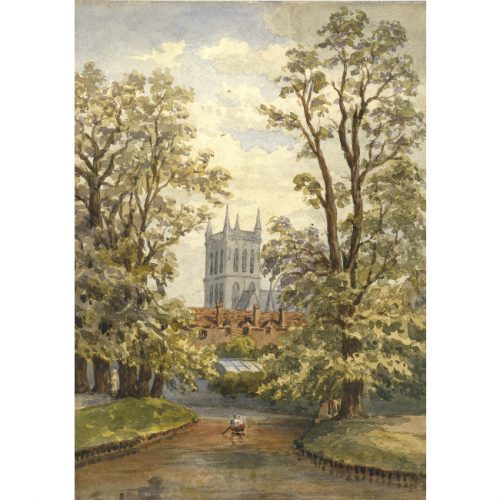-

Anonymous St. John’s College, Cambridge
Watercolour 32x24.5cm If you are interested email info@manningfineart.co.ukor call us on 07929 749056. Condition: Good. -
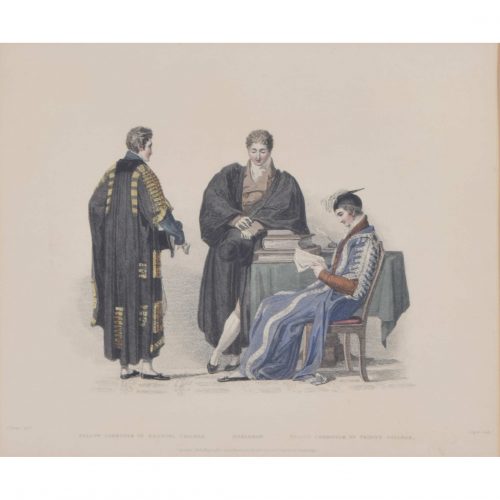
John Samuel Agar (1773 - 1858) after John Uwins (1782 - 1857)
Fellow Commoner of Emanuel College; a Nobleman; Fellow Commoner of Trinity College (1815)
Hand-coloured aquatint 25 x 29.5 cm Published by Rudolph Ackermann (1764 - 1834). An engraving of two students and a nobleman from Ackermann's ''A History of the University of Cambridge, Its Colleges, Halls and Public Buildings''. The three figures dwell over a pile of books and papers, clad in the appropriate academic dress. Thomas Uwins RA RWS was a British painter in watercolour and oil, and a book illustrator. He became a full member of the Old Watercolour Society and a Royal Academician, and held a number of high-profile art appointments including the librarian of the Royal Academy, Surveyor of Pictures to Queen Victoria and the Keeper of the National Gallery. In the late 1790s he began producing work for Ackermann''s collections. John Samuel Agar was an English portrait painter and engraver, who exhibited his works at the Royal Academy from 1796 to 1806 and at the British Institution until 1811. He was at one time president of the Society of Engravers. Rudolph Ackermann published many of his engravings. Rudolph Ackermann was an Anglo-German bookseller, inventor, lithographer, publisher and businessman. In 1795 he established a print-shop and drawing-school at 96 Strand. Here Ackermann set up a lithographic press and began a trade in prints. He later began to manufacture colours and thick carton paper for landscape and miniature painters. Within three years the premises had become too small and he moved to 101 Strand, in his own words "four doors nearer to Somerset House", the seat of the Royal Academy of Arts. Between 1797 and 1800 Ackermann rapidly developed his print and book publishing business, encompassing many different genres including topography, caricature, portraits, transparencies and decorative prints. Condition: good. Some age toning. If you’d like to know more, please email info@manningfineart.co.uk or call us on 07929 749056. -
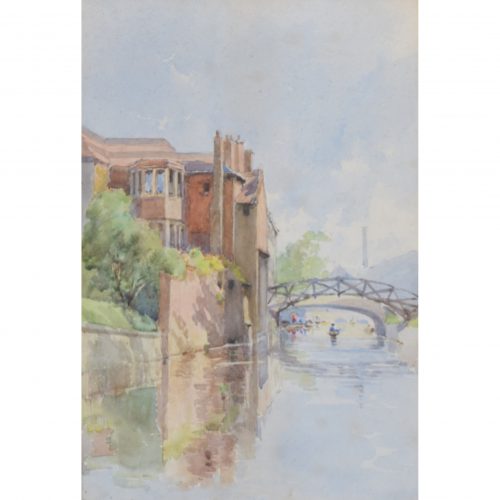
The Mathematical Bridge, Queens' College, Cambridge
Watercolour 27 x 18 cm A delightful watercolour of Cambridge's famous Mathematical Bridge. Figures punt under the bridge and the buildings of Queens are reflected in the serene waters of the River Cam. Kate Hillman of the Cambridge University Engineering Department notes that: "One of the most recognisable structures on the Cam, Queens' College bridge was originally built in 1749 by James Essex the Younger. Since then it has been rebuilt twice to the original design of William Etheridge, once in 1866 and again in 1905. In 1866 the bridge deck was changed from a stepped design to the current sloped deck. In 1905 a complete rebuild of the bridge was required due to weathering of the original oak structure. stories have suggested that a group of students (or professors, depending on the storyteller) disassembled the bridge to discover how it stood up and then couldn't put it back together. The bridge was supposedly then rebuilt using rather prominent bolts." Condition: very good; gilt frame has some age. If you’d like to know more, please email info@manningfineart.co.uk or call us on 07929 749056. -
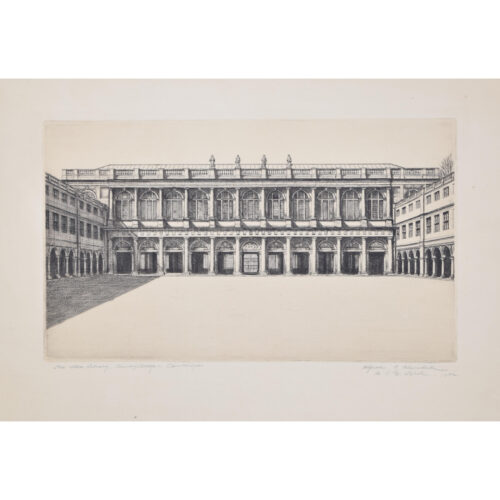
Alfred Richard Blundell (1883 - 1968)
The Wren Library, Trinity College, Cambridge
Etching 15 x 25 cm Signed, titled and inscribed 'to C A Walsh 1952' in pencil. Trinity's magnificent Wren Library was designed by Christopher Wren in 1676 and completed in 1695. Here, the artist captures the library's imposing architectural symmetry. Alfred Blundell was a painter, printmaker and glass engraver who studied at the Slade School of Fine Art. He exhibited at the Royal Academy and the Fitzwilliam Museum, Cambridge holds several of his pictures. Condition: generally very good; old tape reside to very corners. If you are interested, please email info@manningfineart.co.uk or call us on 07929 749056. Click here for other views of Trinity College, Cambridge. -
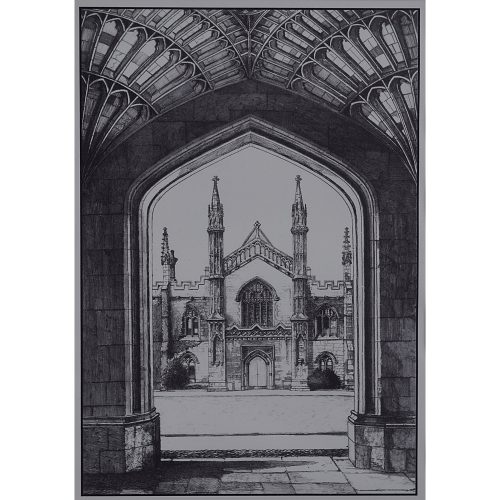
Tony Broderick (British, late 20th Century) Corpus Christi College Cambridge
Print 35x25cm A Lincoln-based artist, known for his portrayal of Lincoln and also of the Cambridge Colleges. If you are interested email info@manningfineart.co.uk or call us on 07929 749056. Condition: Excellent. -
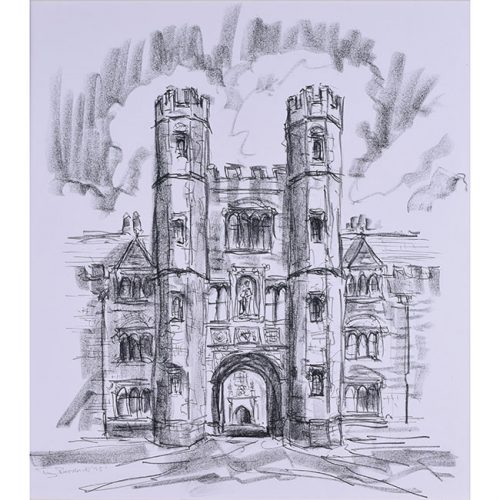
Tony Broderick
Shrewsbury Tower St. John's College Cambridge
Conte drawing 35x32cm If you are interested email info@manningfineart.co.uk or call us on 07929 749056. -

Tony Broderick
St. John's Great Gate, Cambridge
Conte drawing 33x42cm If you are interested email info@manningfineart.co.uk or call us on 07929 749056. -
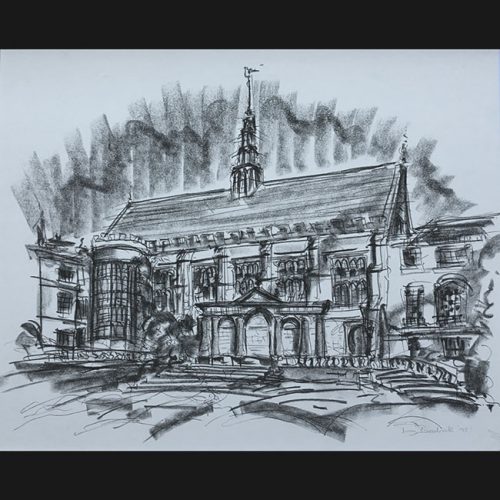
Tony Broderick
Trinity College, Cambridge, Hall from exterior
Conte drawing 37x47cm If you are interested email info@manningfineart.co.uk or call us on 07929 749056. -
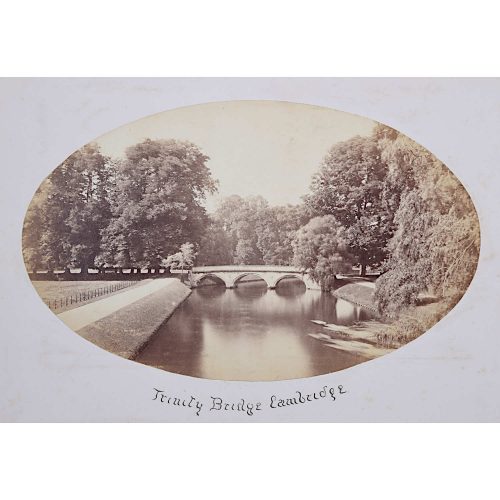
Trinity Bridge, Cambridge
Albumen print of a photograph, circa 1850 Mounted to board and inscribed 'Trinity Bridge Cambridge'. Trinity Bridge is a stone built tripled-arched road bridge across the River Cam. It was built from Portland stone in 1765 to the designs of James Essex to replace an earlier bridge built in 1651, and is a Grade I listed building. Trinity College is a constituent college of the University of Cambridge, and was founded in 1546 by King Henry VIII. Trinity is one of the oldest and largest colleges in Cambridge, with the largest financial endowment of any college at either Cambridge or Oxford. Trinity has some of the most distinctive architecture within Cambridge, with its Great Court reputed to be the largest enclosed courtyard in Europe. Condition: generally very good. If you’d like to know more, please email info@manningfineart.co.uk or call us on 07929 749056. -
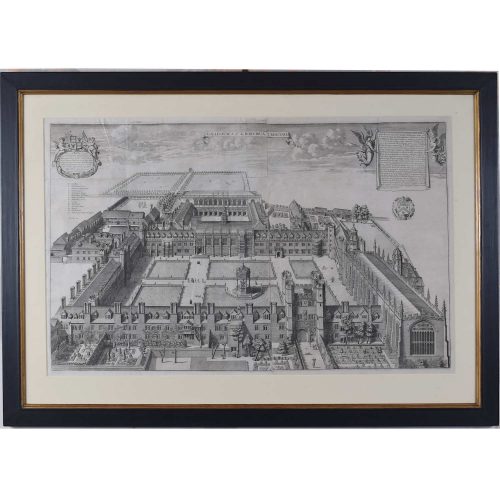
David Loggan (1634 - 1692)
Trinity College, Cambridge (1690)
Engraving 80 x 50 cm Loggan was born to English and Scottish parents, and was baptised in Danzig in 1634. After studying engraving in Danzig with Willem Hondius (1598-1652 or 1658), he moved to London in the late 1650s, going on to produce the engraved title-page for the folio 1662 Book of Common Prayer. He married in 1663 and moved to Nuffield in Oxfordshire in 1665. Loggan was appointed Public Sculptor to the nearby University of Oxford in the late 1660s, having been commissioned to produce bird’s-eye views of all the Oxford colleges. He lived in Holywell Street as he did this. The 'Oxonia Illustrata' was published in 1675, with the help of Robert White (1645 - 1704). Following its completion, Loggan began work on his equivalent work for Cambridge; the 'Cantabrigia Illustrata' was finally published in 1690, when he was made engraver to Cambridge University. The 'Oxonia Illustrata' also includes an engraving of Winchester College (Winchester and New College share William of Wykeham as their founder) whilst the 'Cantabrigia Illustrata' includes one of Eton College (which shares its founder, Henry VIII, with King’s College). Bird’s-eye views from this era required a particular talent as an architectural perspectivist; it was not until 1783 that it became possible for artists to ascend via hot air balloons and view the scenes they were depicting from above. Loggan thus had to rely on his imagination in conceiving the views. Loggan’s views constitute the first accurate depictions of the two Universities, in many ways unchanged today. Whilst the Oxford engravings were produced in reasonable numbers and ran to a second edition by Henry Overton (on thicker paper and with a plate number in Roman numerals in the bottom right-hand corner), those of Cambridge were printed in much smaller numbers. The Dutchman Pieter van der Aa published some miniature versions of the engravings for James Beverell’s guidebook to the UK, 'Les Delices de la Grande Bretagne' (circa 1708). The contemporary artist Andrew Ingamells has produced a highly-acclaimed series of etchings which bring Loggan’s original vision up to date. Condition: generally very good; printed on two sheets, folds as issued. A few creases to top area. As a multi-folded plate in the published book, Trinity has normally suffered and is normally trimmed closely and has damage; this particular example has instead good margins outside the platemark and without damage to the folds. A very good copy of Trinity. If you’d like to know more, please email info@manningfineart.co.uk or call us on 07929 749056. -
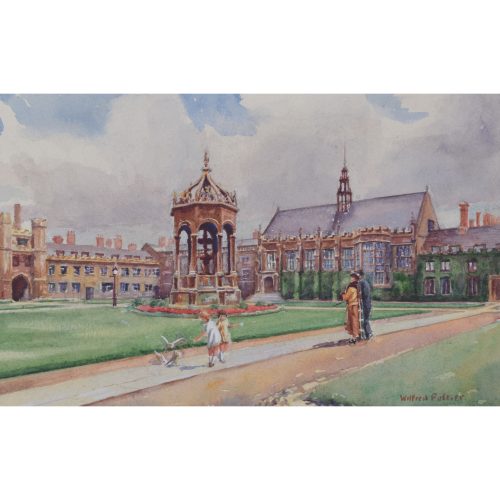
Wilfred Pettitt (1904 - 1978)
Great Court, Trinity College, Cambridge
Watercolour 17 x 27 cm A smartly-dressed couple and their two children enjoy the sunny and immaculately-lawned Great Court of Trinity College, Cambridge. The man and woman admire the ornate fountain which stands sentinel in the middle of the court (it, along with the rest of Great Court, was erected by by Thomas Nevile, master of the college in the early 17th century). Their children, perhaps oblivious to the architectural majesty around them, amuse themselves by playing with the pigeons. Wilfred Stanley Pettitt was born in Great Yarmouth, and studied at the Great Yarmouth School of Art and the Norwich School of Art. In 1928 he showed at the Royal Academy Royal Academy for the first time, and his work was also exhibited by the Royal Society of British Artists and the Royal Cambrian Academy. In 1944 Pettitt became one of the founding members of the Norwich Twenty Group (a group of Norfolk artists who intended to raise the standards of local professional art). He died in Eastbourne in 1978. Condition: mounted to board; otherwise very good. If you are interested, please email info@manningfineart.co.uk or call us on 07929 749056. Click here for other views of Trinity College, Cambridge. -
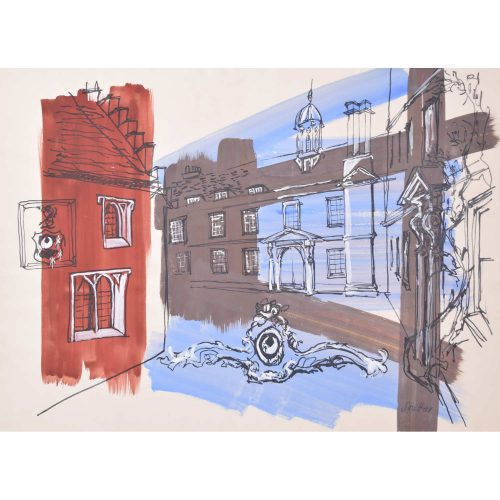
Margaret Souttar (1914 - 1987)
Trinity Hall, Cambridge I
Acrylic paint 55 x 76 cm Signed in pencil lower right. Souttar was a Scottish painter and printmaker known for her images of town- and cityscapes. In the early 1960s, she was commissioned to produce a series of prints of the Cambridge colleges. She captures the modernity and optimism of 1960s Cambridge; the fact that a female artist was commissioned to create the prints reflects the changing attitudes of the University towards women. Trinity Hall was one of the first Cambridge colleges to admit women as students - it did not do so until 1976. Provenance: the artist's studio sale. Condition: generally very good, a few handling marks. If you are interested, please email info@manningfineart.co.uk or call us on 07929 749056. Click here for other views of Trinity Hall. -
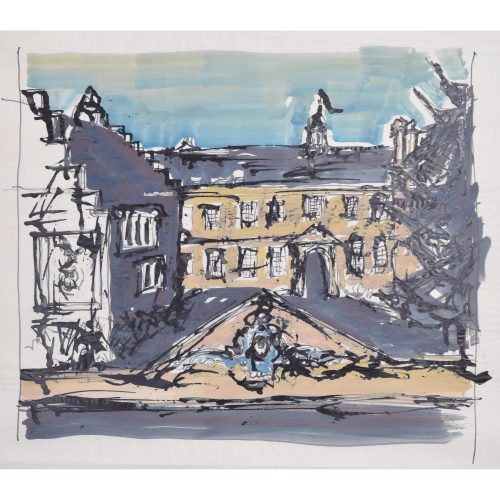
Margaret Souttar (1914 - 1987)
Trinity Hall, Cambridge II
Acrylic paint 56 x 65 cm cm Souttar was a Scottish painter and printmaker known for her town- and cityscapes. In the early 1960s, she was commissioned to produce a series of prints of the Cambridge colleges. She captures the modernity and optimism of 1960s Cambridge; the fact that a female artist was commissioned to create the prints reflects the changing attitudes of the University towards women. Trinity Hall was one of the first Cambridge colleges to admit women as students – it did not do so until 1976.6. Provenance: the artist's studio sale. Condition: generally very good, some crinkling as a result of using water-based paints on thin paper. If you are interested, please email info@manningfineart.co.uk or call us on 07929 749056. Click here for other views of Trinity Hall. -
Out of stock
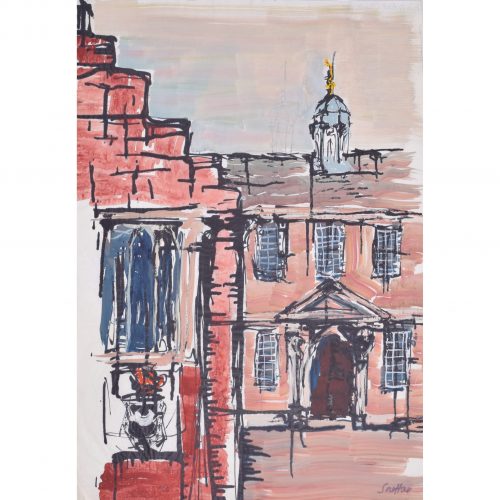
Margaret Souttar (1914 - 1987)
Trinity Hall, Cambridge IV
Acrylic paint 62 x 92 cm Signed lower right. Souttar was a Scottish painter and printmaker known for her images of town- and cityscapes. In the early 1960s, she was commissioned to produce a series of prints of the Cambridge colleges. She captures the modernity and optimism of 1960s Cambridge; the fact that a female artist was commissioned to create the prints reflects the changing attitudes of the University towards women. Trinity Hall was one of the first Cambridge colleges to admit women as students – it did not do so until 1976. Provenance: the artist's studio sale. Condition: generally very good; on thin paper - some crinkling to paper as a result of being painted. Further sketch to reverse. If you are interested, please email info@manningfineart.co.uk or call us on 07929 749056. Click here for other views of Trinity Hall. -
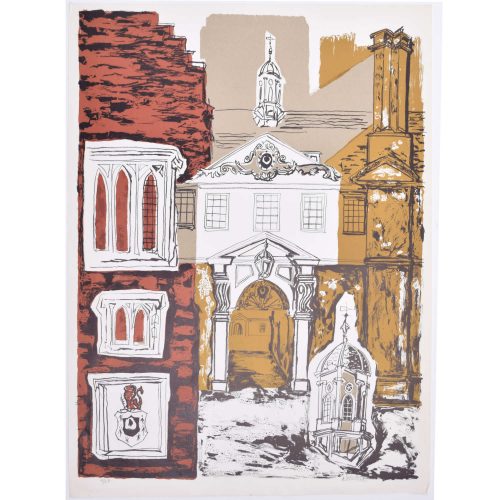
Margaret Souttar (1914 - 1987)
Trinity Hall, Cambridge
Lithograph 76 x 56 cm Signed and numbered 4/50 in pencil. Souttar was a Scottish painter and printmaker known for her images of town- and cityscapes. In the early 1960s, she was commissioned to produce a series of prints of the Cambridge colleges. She captures the modernity and optimism of 1960s Cambridge; the fact that a female artist was commissioned to create the prints reflects the changing attitudes of the University towards women. Trinity Hall was one of the first Cambridge colleges to admit women as students - it did not do so until 1976. Provenance: the artist's studio sale. Condition: generally very good; a few handling marks. If you are interested, please email info@manningfineart.co.uk or call us on 07929 749056. Click here for other views of Trinity Hall. -

Margaret Souttar (1914-1987)
Trinity Hall, Cambridge
Acrylic on paper 76 x 56 cm Signed lower right. Souttar was a Scottish painter and printmaker known for her images of town- and cityscapes. In the early 1960s, she was commissioned to produce a series of prints of the Cambridge colleges. She captures the modernity and optimism of 1960s Cambridge; the fact that a female artist was commissioned to create the prints reflects the changing attitudes of the University towards women. Trinity Hall was one of the first Cambridge colleges to admit women as students - it did not do so until 1976. Provenance: the artist's studio sale. Condition: generally very good; some small glue stains around collaging. If you are interested, please email info@manningfineart.co.uk or call us on 07929 749056. Click here for other views of Trinity Hall. -
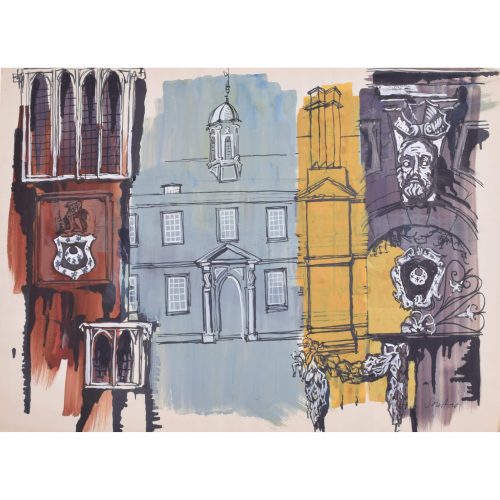
Margaret Souttar (1914 - 1987)
Trinity Hall, Cambridge V
Acrylic paint 56 x 72 cm Signed lower right. Souttar was a Scottish painter and printmaker known for her images of town- and cityscapes. In the early 1960s, she was commissioned to produce a series of prints of the Cambridge colleges. She captures the modernity and optimism of 1960s Cambridge; the fact that a female artist was commissioned to create the prints reflects the changing attitudes of the University towards women. Trinity Hall was one of the first Cambridge colleges to admit women as students – it did not do so until 1976. Provenance: the artist's studio sale. Condition: generally very good. If you are interested, please email info@manningfineart.co.uk or call us on 07929 749056. Click here for other views of Trinity Hall. -
Out of stock
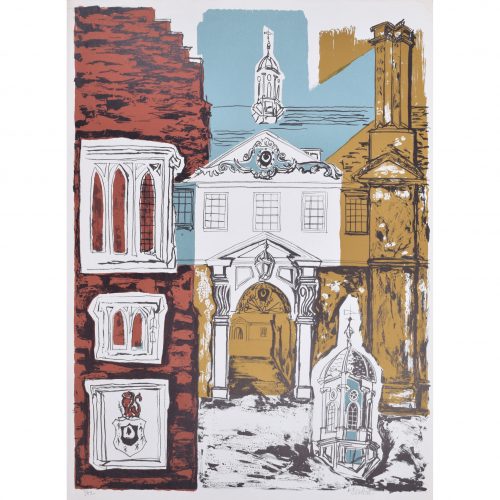
Margaret Souttar (1914 - 1987)
Trinity Hall, Cambridge with Blue Sky
Lithograph 76 x 56 cm Numbered 3/50, and signed lower right, in pencil. Souttar was a Scottish painter and printmaker known for her images of town- and cityscapes. In the early 1960s, she was commissioned to produce a series of prints of the Cambridge colleges. She captures the modernity and optimism of 1960s Cambridge; the fact that a female artist was commissioned to create the prints reflects the changing attitudes of the University towards women. Trinity Hall was one of the first Cambridge colleges to admit women as students - it did not do so until 1976. Provenance: the artist's studio sale. Condition: generally very good, the odd very short tear and handling mark affecting outer few millimetres of margin. If you are interested, please email info@manningfineart.co.uk or call us on 07929 749056. Click here for other views of Trinity Hall. -
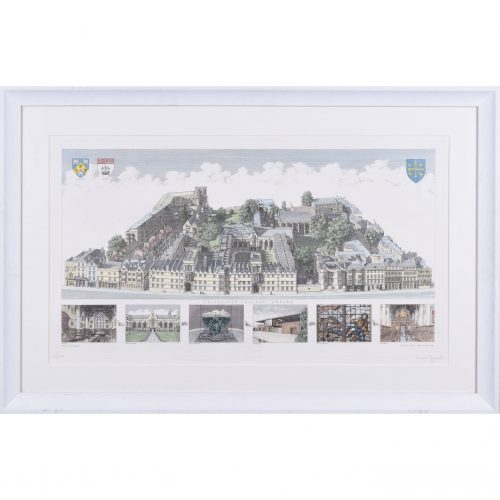
Andrew Ingamells (1956 - )
University College, Oxford
Etching 40 x 70 cm Signed lower right and numbered 15/100 lower left, both in pencil. Inspired by David Loggan’s celebrated engraving of the college, this view of Univ College belongs to Ingamells’ series of views of Oxford and Cambridge. The series took six months to complete and has long-since sold out from the publisher. Ingamells trained at St Albans School of Art and the London College of Printing, subsequently working as a graphic designer and illustrator. Based in London, he began making drawings of the buildings and landscapes of London. Ingamells’ work is in many public collections including those of the Tate Gallery, The National Trust, The Paul Mellon Centre for British Art, and the City of London Guildhall Library. His pictures are also in several private collections, including those of various Oxford and Cambridge colleges, HM King Charles III, and Shell Oil. The artist is currently part-way through his epic project to record all the colleges of Oxford and Cambridge, a project undertaken in homage to David Loggan. Condition: excellent. If you are interested, please email info@manningfineart.co.uk or call us on 07929 749056. Click here for other views of University College, Oxford. -
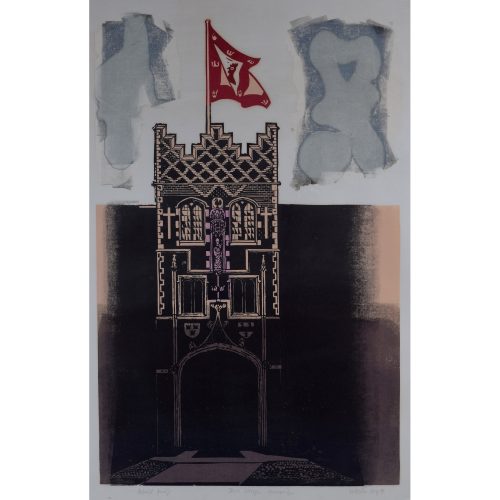
Walter Hoyle
Jesus College Cambridge
Linocut, 1965 76x48 cm Signed and titled in pencil. Printed on handmade Japanese Hosho paper by the artist at Editions Electo Click here for biographical details and other works by the artist. If you are interested email info@manningfineart.co.uk or call us on 07929 749056. -
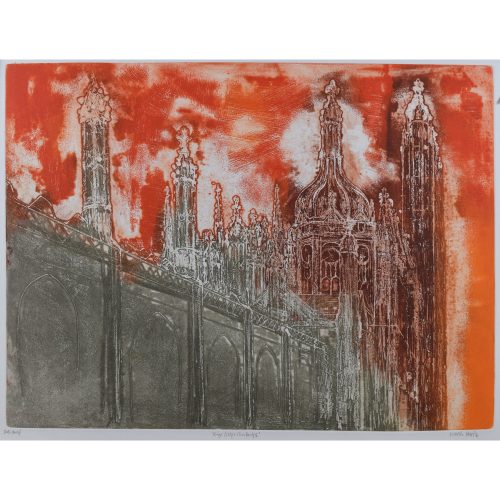
Walter Hoyle (1922 - 2000)
King's College Chapel, Cambridge in red (1965)
Linocut Cambridge Series State Proof, Signed and Titled in pencil. Printed by the artist at Editions Alecto51x69cm Condition: Excellent Click here for biographical details and other works by the artist. If you are interested email info@manningfineart.co.uk or call us on 07929 749056. -
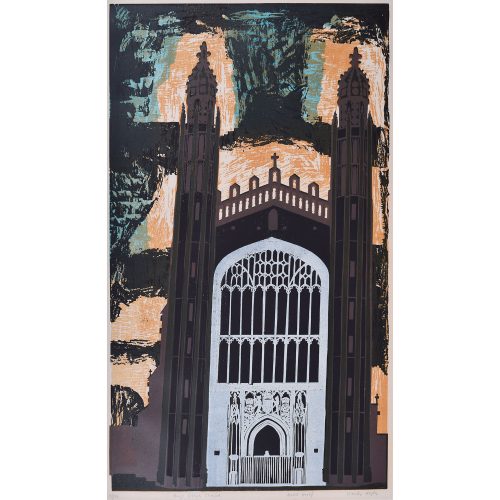
Walter Hoyle (1922 - 2000)
King's College Chapel West End, Cambridge (1965)
Linocut Cambridge Series 51/75, Signed and Titled. Printed by the artist at Editions Alecto71x41cm Click here for biographical details and other works by the artist. If you are interested email info@manningfineart.co.ukor call us on 07929 749056. -
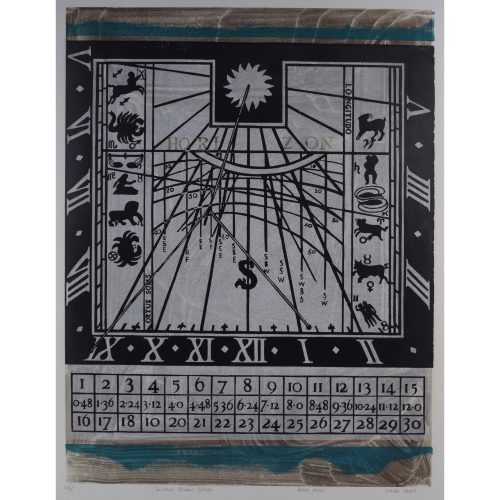
Walter Hoyle
Queens' College Cambridge, Sundial
Linocut, 1965 76x57 cm Signed numbered and titled in pencil. Printed on handmade Japanese Hosho paper by the artist at Editions Electo Click here for biographical details and other works by the artist. If you are interested email info@manningfineart.co.uk or call us on 07929 749056. -
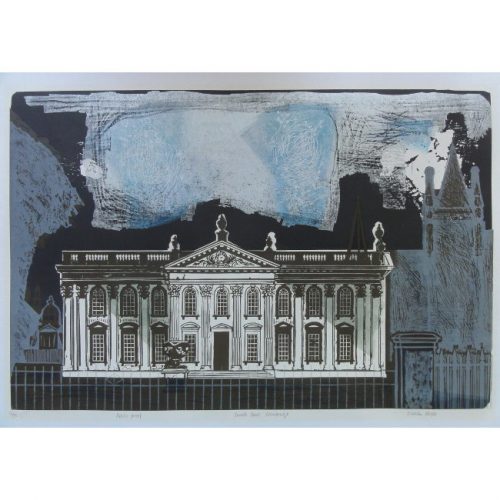
Walter Hoyle (1922-2000)
Senate House, Cambridge (Cambridge Series 1956-6)
Block print 72/75 Artist’s proof, published by Editions Alecto, London, 1966 46x89cm Click here for biographical details and other works by the artist. If you are interested email info@manningfineart.co.uk or call us on 07929 749056. -
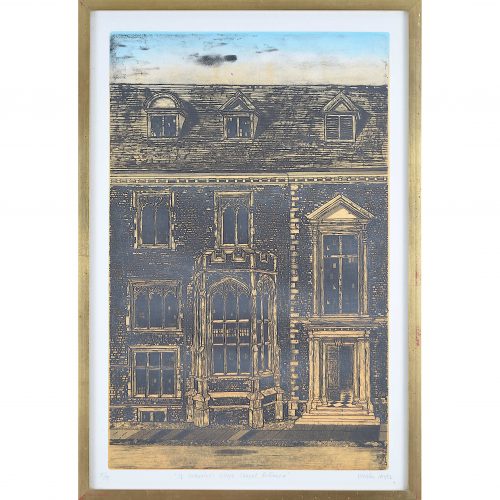
Walter Hoyle (1922-2000)
St Catharine's College, Cambridge (1956-66)
Linocut 59 x 39 cm Signed lower right; inscribed and numbered 35/75 in pencil. Hoyle trained at Beckenham School of Art and the Royal College of Art. At the latter he was strongly influenced by Edward Bawden, one of Britain’s greatest linocut printers. Bawden had been commissioned by the 1951 Festival of Britain to produce a mural for the South Bank, and chose Hoyle to assist on account of his great talent. Hoyle moved to Great Bardfield in Essex, becoming a part of the Great Bardfield group of artists; diverse in style, they created figurative work, in stark contrast to the abstract art of the St Ives artists at the opposite end of the country. Hoyle taught at St Martin’s School of Art from 1951-60, the Central School of Arts and Crafts from 1960-64, and the Cambridge School of Art from 1964-1985, during which time he launched Cambridge Print Editions. His work is held in the collections of the Tate Gallery, the Victoria and Albert Museum, The British Museum, Kettle’s Yard and the Fry Art Gallery. Condition: very good. -
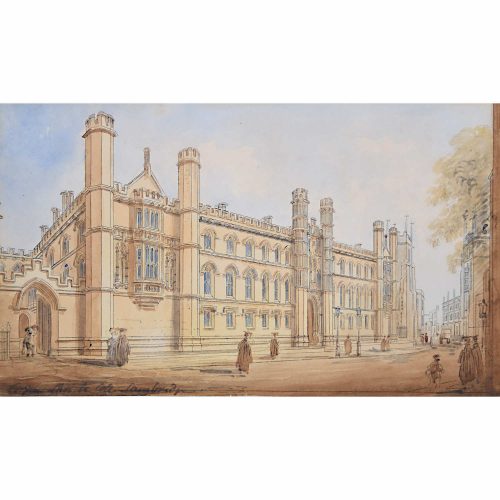
View of Corpus Christi College, Cambridge
Watercolour on paper 13.5 x 23cm A charming view of Corpus Christi College and assorted denizens of Cambridge. The college is notable as the only one founded by Cambridge townspeople; it was established in 1352 by the Guild of Corpus Christi and the Guild of the Blessed Virgin Mary, making it the sixth-oldest college in Cambridge. With around 250 undergraduates and 200 postgraduates, it also has the second smallest student body of the traditional colleges of the University, after Peterhouse. The College has traditionally been one of the more academically successful colleges in the University of Cambridge. It also ranks among the wealthiest Cambridge colleges in terms of fixed assets, being exceptionally rich in silver. Unsigned; labelled 'Corpus Christi Coll. Cambridge' in ink, lower left. If you’d like to know more, please email info@manningfineart.co.uk or call us on 07929 749056. -
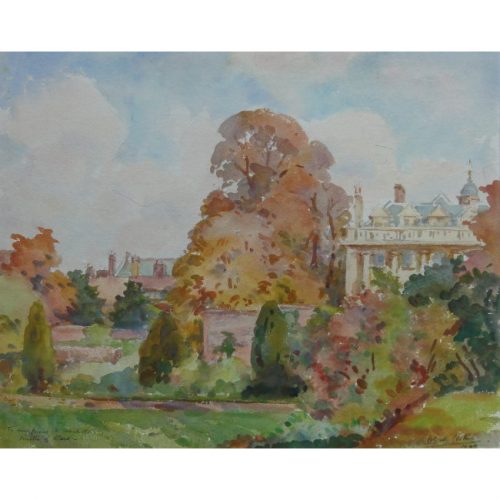
Wilfred Gabriel de Glehn RA (1870-1951)
Clare College from the Backs
Watercolour Inscribed “To my friend H Thirkill Master of Clare” Signed “W de Glehn, 1940” 40x50cm De Glehn painted Henry Thirkill in a portrait that is in the collection of Clare College and may be viewed here. Thirkill was Master between 1939 and 1958 and the portrait was commissioned in 1947. A versatile painter, skilled at portraiture, landscapes and figures de Glehn is regarded as one of England’s premier Impressionist painters. His ability to portray lighting in a lively fashion and his vibrant use of colour combine to provide wonderfully rich paintings. If you are interested email info@manningfineart.co.uk or call us on 07929 749056. -
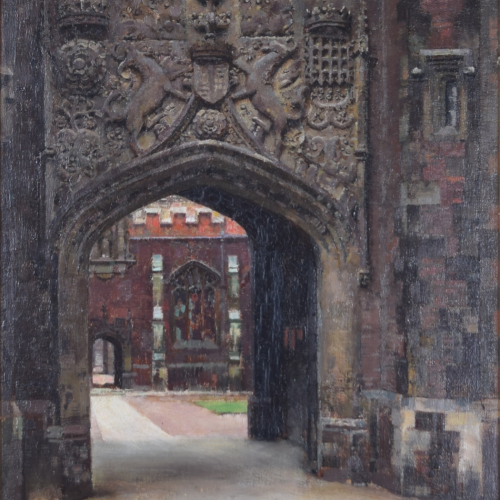
William Logsdail (1859-1944)
St John's College Cambridge, Great Gate
Oil on board 39 x 28 cm Signed lower right. In an original 19th century gilt composition frame. Provenance: the private collection of the late Christopher Wood, a renowned dealer in Victorian art who was a member of St John’s. If you are interested, please email info@manningfineart.co.uk or call us on 07929 749056. -
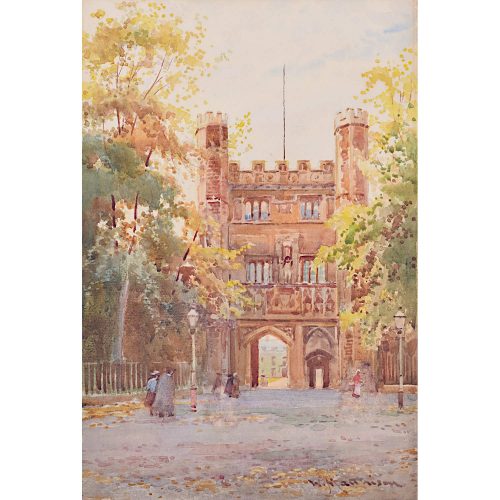
William Matthison (1853-1926)
Trinity College Cambridge Great Gate
Watercolour 36.5 x 26 cm Matthison was born near Birmingham and attended King Edward’s School in the city. He learned drawing at the Birmingham Central School of Art and then became a pupil of Birmingham artist Edward Watson. He became a professional artist in 1875 and moved to Oxfordshire a few years after; this was where he had the opportunity to produce many of the Oxford views for which he is known today. In 1902 he moved to Park Town in Oxford and was commissioned by Robert Peel to paint more than seventy views of the University of Oxford, which were subsequently made into postcards. Priced at seven for a shilling, they were only available from E Cross of Pembroke Street (a long-since closed business). Raphael Tuck & Sons also commissioned him to produce postcard scenes of Cambridge. Matthison’s views of Oxford were later printed in Fifty Watercolour Drawings of Oxford, published in 1912 by Alden & Co. Click here for other works by the artist. If you are interested, please email info@manningfineart.co.uk or call us on 07929 749056. -
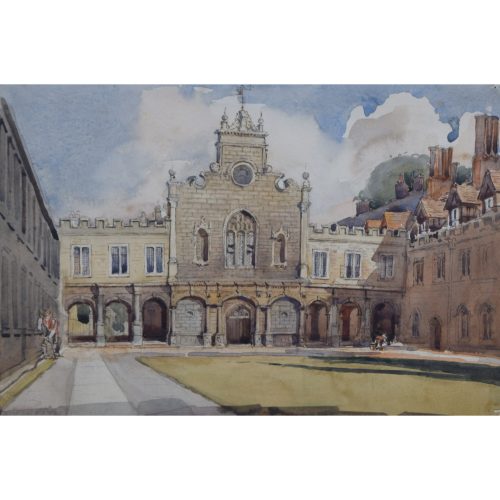
William Thomas Martin Hawksworth (1853-1935)
Peterhouse Cambridge
Watercolour, framed. 17.5 x 26cm. Provenance: with Thomas Agnew & Sons, London A Londoner, Hawksworth was a member of both the RI and RBA. The V&A and British Museum both hold examples of his watercolours. If you are interested email info@manningfineart.co.uk or call us on 07929 749056. -
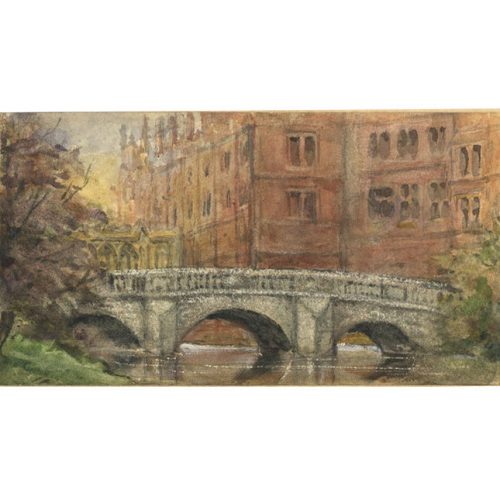
Anonymous
Wren Bridge St. John’s College Cambridge
Watercolour and pencil 8.8×16.7cm A charmingly painted watercolour c. last quarter 19th century If you are interested email info@manningfineart.co.ukor call us on 07929 749056. Condition: Good.

